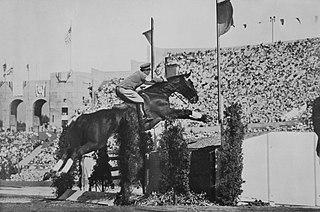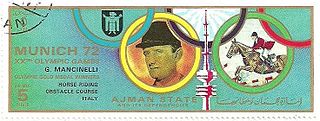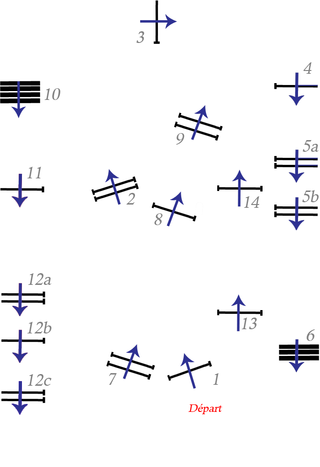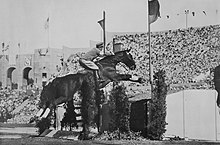
Equestrian at the 1980 Summer Olympics was represented by six events. All of them, with the exception of the Individual Jumping Grand Prix, were held in the Trade Unions' Equestrian Complex, which is situated in the Bitsa Forest Park. Individual Jumping Grand Prix was held in the Grand Arena of the Central Lenin Stadium at Luzhniki.

The equestrian program at the 1912 Summer Olympics in Stockholm, included five medal events. There were individual competitions in dressage, eventing, and show jumping. Team scores were also gathered and medals awarded for teams in the eventing and jumping competitions. Equestrian had been absent from the Olympic program since the 1900 Summer Olympics, making the 1912 Games the second time the sport was featured. Ten nations competed: Belgium, Chile, Denmark, France, Germany, Great Britain, Norway, Russia, Sweden, and the USA. Only Sweden and Germany were able to supply a full team for all three disciplines, with several countries having several riders and horses used in two or even all three disciplines. A total of 88 entries ran in the three events, with 62 riders and 70 horses.

The equestrian events at the 1928 Summer Olympics included dressage, eventing, and show jumping. All three disciplines had both individual and team competitions. The competitions were held from 8 to 12 August 1928. Teams were now fielded by three riders, rather than four, the purpose being to reduce pressure on national federations to find that many riders in order to compete for team medals. Riders had to be considered amateurs, which was defined as either an actively serving professional officer, or as a gentleman rider as defined by the rules of that rider's national governing body. A total of 113 entries were present from 20 nations: Argentina, Austria, Belgium, Bulgaria, Czechoslovakia, Denmark, Finland, France, Germany, Hungary, Italy, Japan, the Netherlands, Norway, Poland, Portugal, Spain, Sweden, Switzerland, and the USA. This was the first appearance for Hungary, Japan and Argentina in equestrian events at an Olympics. Additionally, after being shut out from two Olympic competitions, Germany also returned to the Games to win a few medals in the equestrian events.

The equestrian events at the 1932 Los Angeles Summer Games included dressage, eventing, and show jumping. The competitions were held from 10 to 14 August 1932. Due to the Great Depression, only 31 entries from 6 nations competed—which was to be the lowest participation of any Olympic Games.

The equestrian events at the 1936 Berlin Summer Olympics included dressage, eventing, and show jumping. All three disciplines had both individual and team competitions. The host country, Germany, had a stellar year, winning both individual and team gold in every equestrian event, as well as individual silver in dressage. The competitions were held from 12 to 16 August 1936. Moderately priced tickets meant huge crowds at all equestrian events, with 15,000–20,000 spectators at any time during the dressage competition, 60,000 on the endurance day of eventing, and 120,000 for the Nations Cup in jumping.

Equestrian sports were first included in the Olympic Games in the Summer Olympics of 1900 in Paris. They were again included in 1912, and have been included in every subsequent edition of the Games. The Olympic equestrian disciplines are dressage, eventing, and show-jumping. In each discipline, both individual and team medals are awarded. Women and men compete on equal terms.

The individual show jumping was an equestrian event held as part of the Equestrian at the 1964 Summer Olympics programme. The event was held on 24 October. There were 46 competitors from 17 nations. Each nation could have up to three riders. The event was won by Pierre Jonquères d'Oriola of France, the first rider to win two gold medals in individual jumping; he did so 12 years apart, with his first in 1952. It was France's third gold medal in the event overall, moving out of a tie with Italy at two for most all-time. Hermann Schridde, representing the United Team of Germany, took silver. Great Britain earned its second consecutive bronze in the event, this time with Peter Robeson taking the honors.

The individual show jumping was an equestrian event held as part of the Equestrian at the 1912 Summer Olympics programme. The competition was held on 16 July 1912 as the Stockholm Olympic Stadium. There were 31 competitors from 8 nations. Each nation was limited to a maximum of six riders. The event was won by Jacques Cariou of France, the nation's first victory in the individual jumping. The victory came with a challenge prize presented by Count Gyula Andrássy the Younger of Hungary. Rabod von Kröcher earned Germany's first medal in the event with his silver. Emmanuel de Blommaert of Belgium took bronze.

The individual show jumping event was part of the equestrian programme at the 1920 Summer Olympics. The competition was held on 12 September at the Olympisch Stadion in Antwerp. There were 25 competitors from 6 nations. The event was won by Tommaso Lequio di Assaba of Italy, with his teammate Alessandro Valerio earning silver. Carl Gustaf Lewenhaupt of Sweden took bronze. They were the first medals in individual jumping for both nations.

The individual show jumping was one of five equestrianism events on the Equestrian at the 1924 Summer Olympics programme. The competition was held on Saturday 27 July 1924. 43 riders from 11 nations competed. Nations were limited to four riders each; the team jumping event used the same results as this competition, with the top three individual scores counting for each national team. The individual event was won by Alphonse Gemuseus of Switzerland, with the nation winning its first victory in its debut in the individual jumping event. Tommaso Lequio di Assaba of Italy became the first person to win multiple medals in the event, taking silver to add to his 1920 gold. Adam Królikiewicz earned Poland's first individual jumping medal with his bronze.

The individual show jumping in equestrian at the 1972 Summer Olympics in Munich was held at Olympic Stadium on 3 September. It was open to men and women. There were 54 competitors from 21 nations, with two additional non-starters. The event was won by Graziano Mancinelli of Italy, the nation's first victory in individual jumping since 1960 and third overall, tying France for most of all nations. Great Britain extended its podium streak in the event to four Games with Ann Moore's silver. The United States reach the podium for a second straight Games as Neal Shapiro took bronze.

The individual show jumping in equestrian at the 1948 Summer Olympics in London was held at the Wembley Stadium on 14 August. The competition consisted of a single round of jumping. In the case of a tie in points, a jump-off was arranged. The jump-off had no time limit, however, the time taken to complete the jump-off was used as a tie-breaker. The points from the individual competition were also used in the team competition. There were 44 competitors from 15 nations, with nations able to send up to three riders each. The event was won by Humberto Mariles of Mexico, with his teammate Rubén Uriza taking silver at the top of a three-way jump-off for second place. Mariles' win was Mexico's first victory in the event. Jean-François d'Orgeix of France earned that nation's first individual jumping medal since 1928 with his bronze.

The individual eventing in equestrian at the 1932 Summer Olympics in Los Angeles was held at the Riviera Country Club (dressage), a specially built course in Westchester (cross-country), and the Olympic Stadium (jumping) from 10 to 13 August. NOCs were limited to three horse and rider pairs.

The individual eventing event at the 2020 Summer Olympics is scheduled to take place from 30 July to 2 August 2021 at the Baji Koen and Sea Forest Cross-Country Course. Like all other equestrian events, the eventing competition is open-gender, with both male and female athletes competing in the same division. 65 riders from 29 nations are expected to compete.

The team show jumping event at the 2020 Summer Olympics took place on 6–7 August 2021 at the Baji Koen. Like all other equestrian events, the jumping competition was open-gender, with both male and female athletes competing in the same division. 60 riders from 20 nations competed. The event was won by team Sweden, which included Peder Fredricson, the silver medalist in the individual event. The United states were second, and Belgium third.

The individual show jumping in equestrian at the 1936 Olympic Games in Berlin was held at the Olympiastadion (jumping) on 16 August. The competition was also referred to as the "Prix des Nations." There were 54 competitors from 18 nations, with each nation having a team of three riders. The results of the individual event were used for the team jumping event as well. The individual event was won by Kurt Hasse of Germany, the nation's first victory in individual jumping and first medal in the event since 1912. Romania and Hungary each earned their first individual jumping medals, the former with Henri Rang's silver and the latter with József von Platthy's bronze.

The individual show jumping or "Prix des Nations" at the 1952 Summer Olympics took place on 3 August, at the Helsinki Olympic Stadium. It was the ninth appearance of the event. For the first time, the event featured two rounds. There were 51 competitors from 20 nations, with each nation able to send a team of up to three riders with the results shared between team and individual events. The event was won by Pierre Jonquères d'Oriola of France, the nation's first victory in individual jumping since 1912 and second overall. Óscar Cristi of Chile took silver for that nation's first medal in the event. German rider Fritz Thiedemann earned bronze.

The individual show jumping at the 1956 Summer Olympics took place on 17 June, at the Stockholm Olympic Stadium. The event was open to men and women, with two women competing. It was the 10th appearance of the event. There were 66 competitors from 24 nations, with each nation able to send a team of up to three riders and the team and individual events sharing results. The event was won by Hans Günter Winkler of the United Team of Germany, a victory in the debut for that nation though Germany had won in 1936. Brothers Raimondo D'Inzeo and Piero D'Inzeo took silver and bronze, respectively, the first medals for Italy in individual jumping since 1924.

The individual show jumping at the 1960 Summer Olympics took place on 7 September, at the Stadio Olimpico. The event was open to men and women. It was the 11th appearance of the event. There were 60 competitors from 23 nations. Each nation could have up to three riders. The event was won by Raimondo D'Inzeo of Italy, with his elder brother Piero D'Inzeo taking silver. The brothers were the second and third riders to win multiple medals in individual jumping; all three were Italian. It was the nation's first gold medal in the event since Lequio di Assaba's in 1920; Italy's two golds tied France for most all-time. David Broome earned Great Britain's first medal in the event with his bronze.

The individual show jumping at the 1988 Summer Olympics took place between 26 September and 2 October at the Seoul Olympic Stadium. It featured a significant change to the competition format from prior years. The event was open to men and women. There were 74 competitors from 24 nations. Each nation could have up to 4 riders, up from 3 in previous years. The event was won by Pierre Durand Jr. of France, the nation's first victory in individual jumping since 1964 and fourth overall—most of any nation, moving out of a tie with Italy at three. Silver went to Greg Best of the United States, with bronze to Karsten Huck of West Germany.



















